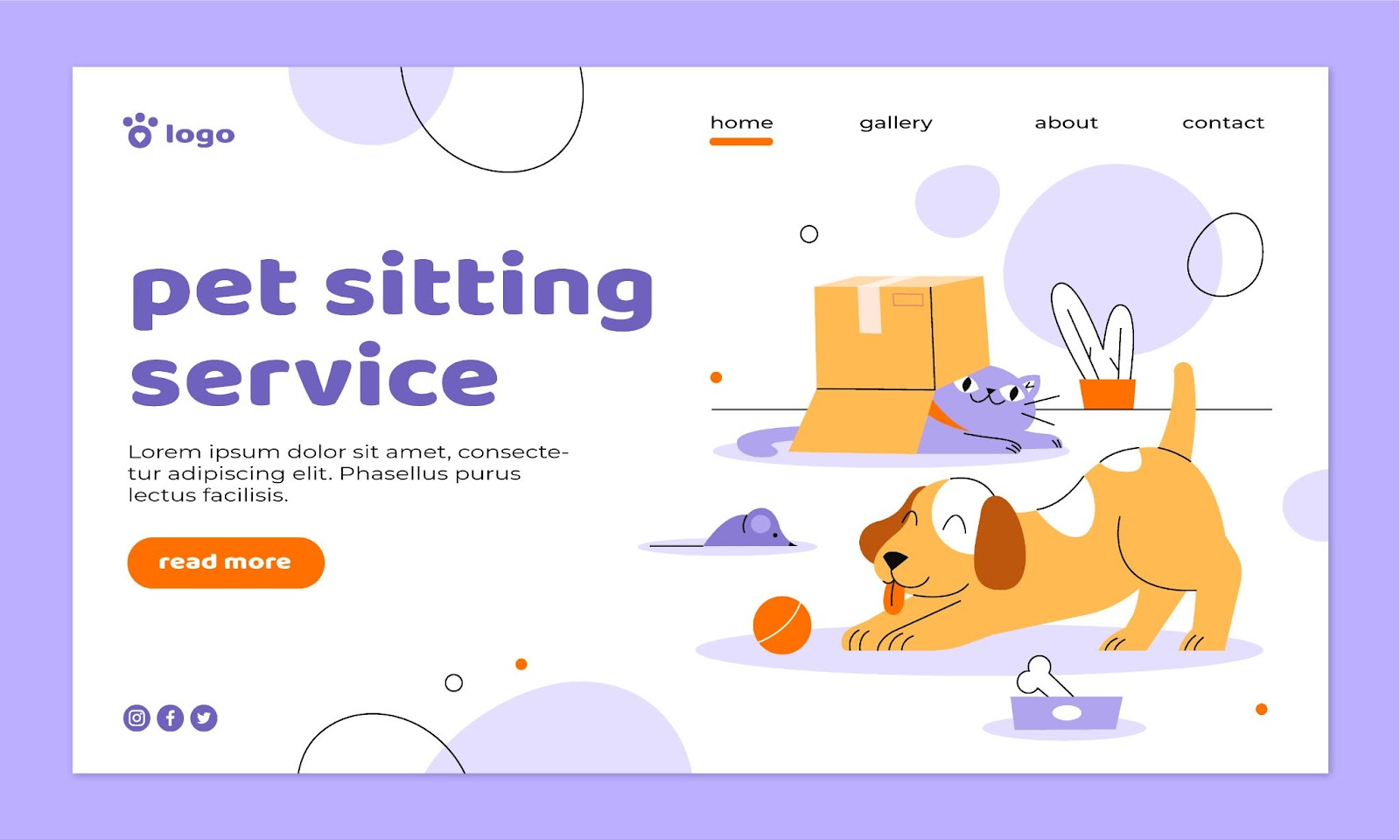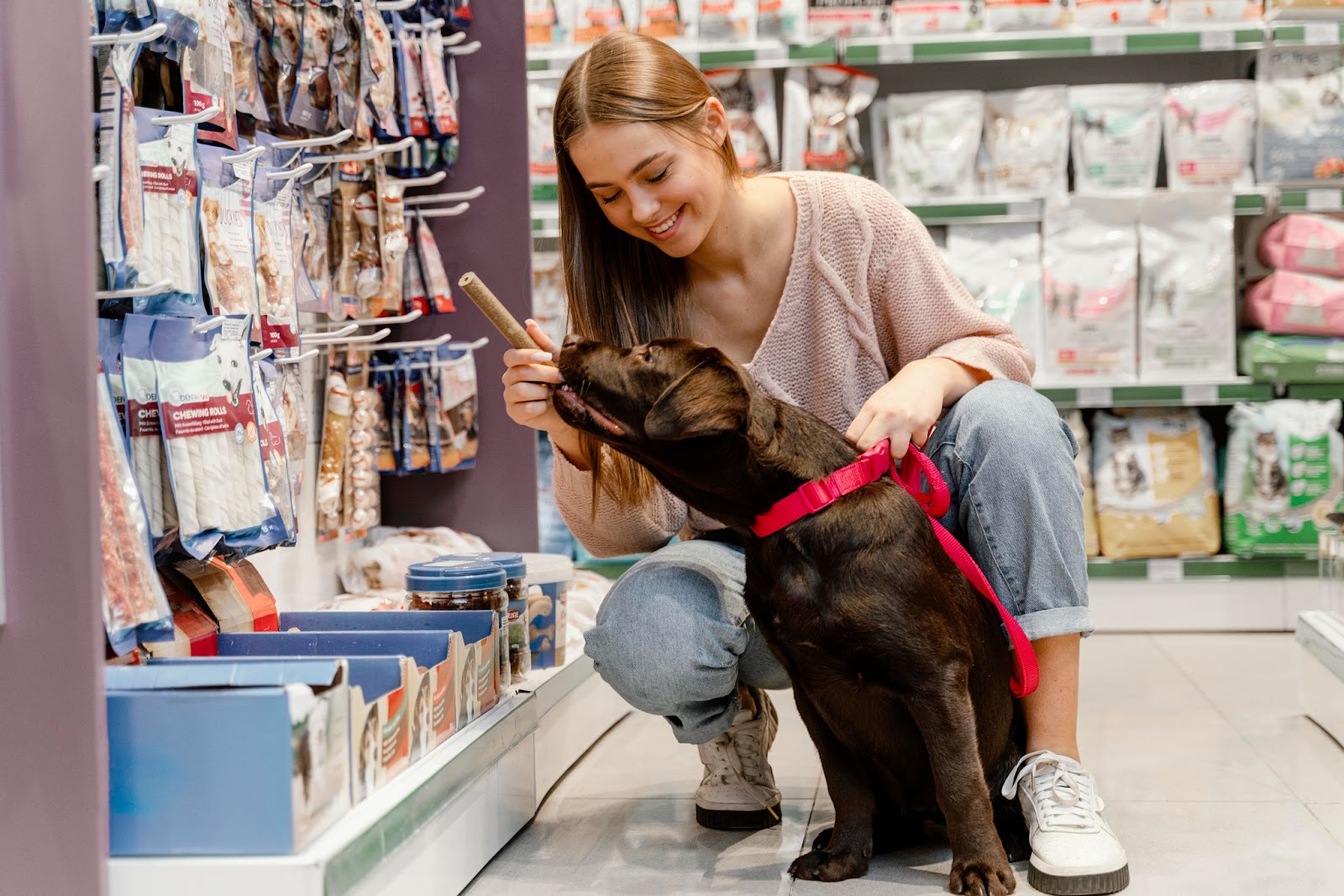The Ultimate Guide to Open a Pet Supply Store

The pet industry is booming, fueled by the ever-growing love for our furry, feathered, and scaled companions. If you’ve ever dreamt of turning your passion for pets into a successful business, then opening a pet supply store could be the perfect path for you! But where do you even begin?
This handy guide will provide you with the information and actions required to achieve your goal. We will cover every detail, including choosing the best business concept, getting funding, and welcoming your first furry customer.
Ready to dive in? Let’s go!
Choosing Your Path: Exploring Pet Store Formats
Before diving into the steps of opening a pet supply store, it’s important to decide what type of store you want to run. There are three main types:
Online

Starting an online pet supply business has pros and cons. One of its biggest advantages is the lack of rent and utility expenditures from a physical storefront. Location flexibility lets you reach clients nationwide, breaking away from local marketplaces. Additionally, the online approach also offers a wide range of products that may not be available in a traditional store, catering to niche markets and specialized consumer demands. Moreover, inventory management becomes more streamlined with the help of technology, reducing the need for large storage spaces.
However, there are downsides to consider. The limited customer interaction can impact the personal connection and relationship building often found in in-person shopping experiences. Also, without a physical presence, it’s more challenging to offer services such as grooming, training, or hosting adoption events, which are valuable to pet owners. Another concern is the potential for high shipping costs, which can eat into profit margins—this is particularly true for heavy items like pet food or large beds.
This business model is ideal for entrepreneurs with a strong online presence focusing on niche product selections. It’s also well-suited for budget-conscious people looking to minimize startup costs.
The Brick-and-Mortar

Opening a physical pet supply store presents a different set of opportunities and challenges compared to an online business. Building relationships with customers, fostering a sense of community, and connecting with pet owners on a personal level are significant advantages. Physical stores can offer valuable in-person services which can make them a one-stop shop for pet care needs. Besides, they can serve as a community hub for pet lovers, providing a space for owners to socialize, share experiences, and seek advice.
On the flip side, operating a brick-and-mortar store comes with higher overhead costs due to rent, utilities, and maintenance. Space constraints within the store also limit the variety of products that can be offered, which may not match the vast selection available online.
This model is particularly well-suited for entrepreneurs who thrive on customer interaction and value the ability to offer additional services. It’s ideal for those who envision their store as more than just a retail space but as a community hub for pet lovers.
The Franchise
Investing in a pet supply franchise offers the advantage of established brand recognition, allowing you to benefit from the franchisor’s existing reputation and customer base. This path also provides a proven business model, which can reduce some of the risks typically associated with starting a new venture. Furthermore, franchisees receive comprehensive support from the franchisor, including access to marketing materials, training sessions, and ongoing assistance.
Regardless, there are drawbacks to consider. Franchise agreements often involve significant upfront fees and ongoing royalty payments, which can be a financial burden. Likewise, franchisees usually have less control over product selection and branding due to the franchisor’s guidelines, which may limit creative freedom.
This business model is ideal for individuals who prefer an organized approach to business, value brand recognition, and appreciate the ongoing support that comes from being part of an established company.
Note: The ideal choice hinges on your budget, experience level, and overall business goals. Here are some questions to consider:
- Do you thrive on face-to-face interactions with customers?
- What kind of budget do you have for startup costs?
- Are you comfortable managing a physical location?
- Do you value the freedom to curate your own product selection and brand identity?
When deciding where to open your facility, these are some of the factors you need to take into account to make the right choice of the format of your pet shop.
Steps to Launching Your Pet Supply Store
Now that you’ve chosen your store format, let’s start the exciting road of growing your business! Here are the key steps involved, ensuring you have a solid foundation for your future pet haven:
Step 1: Market Research: Uncover the Landscape and Become an Expert
- Know Your Competition: Conduct thorough research on existing pet supply stores in your area (if applicable) or within your target online market. Analyze their product offerings, pricing strategies, strengths, and weaknesses. This knowledge will help you identify potential market gaps and tailor your store to stand out.
- Target Market and Customer Insight: Define your ideal customer. Who are you trying to reach? Are they young professionals with new puppies, families with multi-pet households, or seniors caring for cherished companions? Understanding their demographics, pet ownership habits, and purchasing preferences is crucial for crafting targeted marketing strategies and product selections.
- Industry Trends: Dive deep into current trends in the pet industry. Is there a surge in demand for organic pet food? Are wearable pet trackers becoming increasingly popular? Explore and incorporate these trends into your business plan to cater to evolving customer needs and stay competitive.
Step 2: Building Your Brand: A Distinctive Identity that Resonates
- Crafting a Unique Brand: What makes your pet supply store special? What sets you apart from the competition? Do you prioritize high-quality natural products, a focus on specific pet types, or exceptional customer service? Establish what your brand represents to be able to make an impact that will be easily imprinted on the minds of the target consumers.
- A Catchy Name and Logo: The name and logo are the cornerstones of your brand identity. Choose a name that’s easy to remember, reflects your store’s personality, and is relevant to the pet industry. The logo should be visually appealing and consistent with your overall brand image.
- Marketing Masterplan: Develop a comprehensive marketing plan outlining various strategies to reach your target market. This may include creating a user-friendly website, establishing a strong social media presence (adorable pet photos and informative content), implementing email marketing campaigns, or running targeted online ads. For visibility and brand recognition, think about working with nearby animal shelters or pet-related events.
Step 3: Crafting a Solid Business Plan: Your Roadmap to Success
- A Blueprint for Success: Your business plan is your roadmap to achieving your goals. It should outline your mission statement, detailing your purpose and values. Financial projections are crucial, outlining your startup costs, projected revenue streams, and potential profit margins. It will be relevant for the business to come up with a marketing strategy that will best fit the kind of brand it has and that of the target market. Finally, map out your operational plan, including inventory management, logistics (if applicable), and staffing needs.
- Seeking Guidance: Don’t be afraid to seek help! Utilize business plan templates or consult with a business advisor for expert insights. They can guide you through the process, ensuring your plan is comprehensive and realistic.
Step 4: Legal Considerations: Ensuring Compliance and Setting Up Your Business
- Getting the Required Authorizations and Licenses: Find out what particular licenses and permissions your area needs to run a pet supply business.
- Choosing a Business Structure: Decide on the legal structure of your business – sole proprietorship, partnership, LLC, or corporation. Each offers advantages and disadvantages regarding liability, taxes, and business operations. Consult with an accountant and lawyer to determine the structure that best suits your needs.
Step 5: Building Your Dream Team
- Recruitment with a Purpose: Craft compelling job descriptions highlighting your company culture and passion for pets. Look beyond resumes – consider hosting meet-and-greets or volunteer opportunities at local animal shelters to identify individuals who genuinely love animals and possess exceptional interpersonal skills.
- Hiring for Passion and Trainability: While industry experience is a plus, prioritize candidates who demonstrate genuine enthusiasm for pets and a willingness to learn. Look for individuals eager to expand their knowledge and possess excellent communication, problem-solving, and teamwork skills.
- Investing in Comprehensive Training: Remember to underestimate the power of employee training. Create a thorough training program to give your employees the information and skills they need to succeed.
- Building a Positive Work Environment: Create a healthy and supportive workplace culture in which your workers feel valued and appreciated. Offer competitive compensation packages, opportunities for advancement, and recognition programs to incentivize top performance. A happy and motivated team translates to a more enjoyable customer experience.
Step 6: Choosing Suppliers: Building Strong Partnerships for Quality Products
- Research Potential Suppliers: Pinpoint potential vendors by participating in pet sector trade exhibitions, browsing online indexes, or reaching out to well-established pet shops in non-rival regions for suggestions.
- Evaluate Supplier Reputation: Investigate the credibility of potential suppliers. Seek out firms with a demonstrated history of delivering top-notch products, superior customer service, and competitive rates. Peruse online critiques and connect with current customers of the vendors for direct feedback.
- Negotiate Favorable Terms: After pinpointing trustworthy vendors, negotiate advantageous conditions concerning pricing, minimum order volumes, payment timelines, and possible discounts for large-scale purchases.
- Focus on Product Variety and Quality: Make an effort to offer a large selection of goods that satisfy different pet needs, budgets, and species. Put quality above everything else; your clients will appreciate it and reward you with loyal business and enthusiastic recommendations.
Step 7: Develop and Implement Marketing Strategies to Attract Pawsome Customers
-
Develop a User-Friendly Website (if applicable): Create a website that showcases your products, provides transparent pricing, and features high-quality photos. Ensure it’s mobile-friendly for easy browsing on smartphones and tablets. Consider offering online ordering with in-store pickup or delivery options (if applicable).
-
Become a Social Media Star: Make a lasting impression on the social media sites such as Facebook, TikTok, or Instagram that members of your target market visit. Distribute interesting material, such as training guides, product demos, or cute pet pictures. Organize promotions and competitions to create buzz and promote engagement. Encourage a feeling of community by swiftly responding to messages and comments. Consider integrating social media platforms with your online store using tools like Mageplaza Instagram Feed for Shopify. This allows you to automatically display your Instagram feed on your website, creating a seamless shopping experience for customers who discover your brand on social media.
Mageplaza Instagram Feed for Shopify
Engage visitors, build trust, and customize effortlessly. Streamline tasks and boost interaction.
Check it out!
-
Embrace the Power of Email Marketing: Create your email list by providing registration bonuses, such as exclusive discounts or first access to new items. Regularly send out engaging newsletters featuring product highlights, pet care tips, or upcoming events. Personalization goes a long way – segment your email list and tailor content based on recipient preferences.
-
Leverage Traditional Marketing Channels: While digital marketing is crucial, don’t neglect traditional channels entirely. Consider running print ads in local pet publications or community newspapers. Create attractive flyers and distribute them in pet-friendly areas like dog parks or veterinary clinics.
-
Partner with Local Businesses: Collaborate with local animal shelters, rescue organizations, or dog walkers. Offer discounts to their members or host adoption events at your store. This increases your brand’s visibility, promotes goodwill, and links you with prospective clients as passionate about animals as you are.
Step 8: Building Customer Loyalty: Fostering Relationships for Long-Term Success
- Reward Loyal Customers: Establish a loyalty program that rewards our esteemed clients for each purchase they make. This could involve offering points redeemable for discounts, exclusive products, or early access to sale events.
- Customer Service: Train your employees how to give first-rate client service. This includes being knowledgeable about products, offering personalized recommendations, and being genuinely friendly and helpful. A positive in-store experience keeps customers coming back.
- Go Beyond Products: Offer additional services that add value for pet owners. This could include hosting pet training classes, organizing adoption drives, or inviting local veterinarians for Q&A sessions. These initiatives demonstrate your commitment to pet well-being and differentiate your store from the competition.
Step 9: Leveraging Technology for Enhanced Efficiency and Customer Engagement
-
E-commerce Platform Optimization: Choose an e-commerce platform, like Shopify, that fits your business’s wants and growth goals. Think about how easy it is to use, the customization options, the integrations, and the help resources.
- Inventory Management and Order Fulfillment: Consider utilizing inventory management software to monitor stock levels, automate replenishment, and prevent stockouts. As order volumes increase, outsourcing delivery to third-party logistics (3PL) providers can streamline shipping, packaging, and return management, allowing you to concentrate on core business activities.
- Customer Relationship Management (CRM) Tools: Implement CRM software to track customer interactions, purchase history, and provide personalized recommendations to build stronger relationships and encourage repeat business.
- Marketing Automation Tools: Enhance efficiency and save time in your marketing efforts by leveraging marketing automation tools. These tools can automate tasks like managing email marketing campaigns, scheduling social media posts, and sending abandoned cart reminders.
- Chatbots and Live Chat: Integrate chatbots to provide 24/7 customer support, answer frequently asked questions, and guide customers through purchasing. Consider offering live chat during peak business hours for more personalized customer interactions and support.
- Data Analytics and Business Intelligence: Track website traffic, customer behavior, and conversion rates using analytics tools to inform marketing strategies, product development, and overall business decisions.
- Personalization and Recommendations: Employ customer data to customize product recommendations, tailor email marketing campaigns, and adapt website content. This approach boosts customer engagement and enhances the probability of making purchases.
- Mobile Optimization: Ensure your website is tailored for mobile devices to offer a smooth and intuitive shopping journey for users on smartphones and tablets.
- Security and Fraud Prevention: Protect your website and customer data using strong passwords, encryption protocols, and fraud prevention tools. Don’t forget to update your website and software regularly to prevent cyberattacks.
Costs involved in opening a pet supply store
Starting a pet supply store involves various costs that you need to consider. These include:
- Lease or Purchase Costs: The expense of renting or purchasing a physical site for your store. The cost varies considerably based on the property’s size, location, and condition.
- Inventory Costs: To stock your business, you must invest in a wide assortment of pet goods. The kind and quantity of goods you intend to offer will determine the pricing.
- Equipment and Fixtures: This includes shelving, display cases, cash registers, and other necessary store fixtures and equipment.
- Licenses and Permits: Depending on your region, you may be required to get specific licenses and permissions to run a pet supply business.
- Marketing and Advertising: Budget for marketing and advertising expenses to promote your store and attract customers.
- Operating Expenses: These are ongoing costs such as utilities, employee salaries, insurance, and maintenance.
- Professional Services: You may need to engage accountants or attorneys to assist with specific elements of your organization.
Remember, these are just some of the potential costs involved. It’s essential to do thorough research and planning to ensure you have a clear understanding of the financial commitment required to open a pet supply store.
Conclusion
Opening a pet supply store is a thrilling way to combine your love of animals with business. Your ambition may become a successful business with proper preparation, finance, structure, and promotion. Your success depends on selling outstanding items, cultivating customer connections, creating a pleasant and knowledgeable environment, and helping the pet community. So, unleash your passion, follow these steps, and watch your pet supply store blossom into a haven for furry, feathered, and scaled friends – and their devoted humans!









